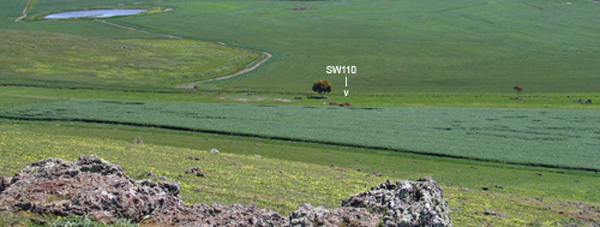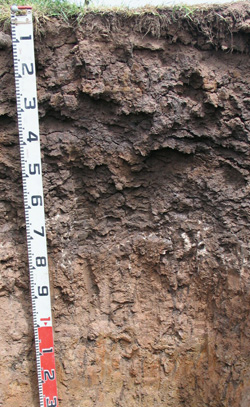SW110
Location: Mt Gellibrand.
Australian Soil Classification: Vertic (& Calcic), Mottled-Mesonatric, Grey SODOSOL (very deep soil profile).
General Landscape Description: Lower part of a slope on the western side of Mt Gellibrand.
Site Description: Grazed area adjacent to cropping area, low slope angle, westerly aspect.
Geology: Almost entirely quartz sand, of uncertain origin - possibly a Tertiary quartz-rich marine sediment. Soil in the pit has also been subject to soil creep and wash from weathering scoria slopes above.
 SW110 Landscape |
Soil Profile Morphology:
Surface Soil
| A1 | 0-5 cm | Very dark greyish brown (10YR3/2); sandy clay loam; moderate fine-very fine polyhedral structure; weak to firm consistence dry; abundant roots throughout; pH 5.9: |  SW110 Profile |
| A2 | 5-12 cm | Brown (7.5YR4/3); rusty root channel mottling; sandy clay loam; weak medium blocky structure; some capping on the columnar structure below; firm to very firm consistence dry; abundant roots throughout; pH 7.3; abrupt change to: | |
| Subsoil | |||
| B21 | 12-30 cm | Dark greyish brown (10YR4/2) with many brown (7.5YR4/4) and dark yellowish brown (10YR4/4) mottles; dark colour along ped faces; heavy clay; moderate to strong very coarse prismatic, parting to strong coarse blocky structure; some columnar structure in patches; very strong consistence dry; pH 6.8: | |
| B22 | 30-45/55 cm | Very dark greyish brown (10YR3/2); heavy clay; strong very coarse prismatic, parting to strong coarse blocky structure; few soft manganese segregations and stains; very few medium (10 mm in size) ferromanganiferous nodules; slickensides present; very strong consistence dry; abrupt and wavy change to; pH 8.4: | |
| B23k | 45/55-90 cm | Dark greyish brown (2.5Y4/2); light medium clay; strong coarse blocky, parting to medium blocky structure; fine-earth carbonates common; slickensides present; pH 9.6: | |
| 2A1 | 90-110 cm | Brown (7.5YR5/4) and dark grey (10YR4/1); sandy loam; moderate medium blocky, parting to fine blocky structure; few coarse (10 mm in size) ferromanganiferous nodules; sand common along cracks; pH 9.7: | |
| 2B1 | 110-130/140 cm | Brown (7.5YR5/4) with yellowish red (5YR4/6) and yellowish brown (10YR5/6) mottles; sandy clay loam (contains well structured light yellowish brown (2.5Y6/3) clay aggregates mixed with sand); strong medium lenticular parting to fine lenticular structure; pH 9.4: | |
| 2B2 | 130/140-180 cm | Light yellowish brown (2.5Y6/3) with brownish yellow (10YR6/6) mottles; light medium clay; strong medium to fine lenticular structure; weak to firm consistence moist; few fine-earth carbonates; some red (10R5/6) soft ochre-like clayey pebbles present in patches; pH 9.4. | |
Key Profile Features:
- Strong texture contrast between surface (A) horizons and subsoil (B21) horizon.
- Vertic features (slickensides, lenticular peds) in subsoil.
- Dense and coarsely structured subsoil (columnar in some areas).
pH | Salinity Rating | |||
Surface (A1 horizon) | Moderately Acid | Low | Sodic | None |
Subsoil (B21 horizon) | Slightly Acid | Low | Sodic | Strong1 |
Deeper subsoil (at 80-110 cm) | Very Strongly Alkaline | High | Strongly Sodic | Slight2 |


| The surface (A) horizon is moderately acid. The upper subsoil is slightly acid becoming alkaline by 30 cm depth and very strongly alkaline at depth. |
|
|
|
Horizon | Horizon Depth (cm) | pH (water) | pH (CaCl2) | EC dS/m | NaCl % | Total Nitrogen % | Organic Carbon % | Exchangeable Cations | |||
Ca | Mg | K | Na | ||||||||
meq/100g | |||||||||||
A1 | 0-5 | 5.9 | 5.1 | 0.12 | 0.45 | 6 | 5.6 | 4.2 | 0.61 | 0.91 | |
A2 | 5-12 | 7.3 | 6.8 | 0.27 | 0.01 | 2.1 | 3.5 | 0.4 | 1.8 | ||
B21 | 12-30 | 6.8 | 5.7 | 0.18 | 5.2 | 12 | 1.5 | 4.3 | |||
B22 | 30-55 | 8.4 | 7.4 | 0.29 | 0.02 | 5.4 | 15 | 1.3 | 6.1 | ||
B23k | 55-80 | 9.6 | 8.7 | 0.77 | 0.08 | 6 | 19 | 0.9 | 11 | ||
2A1 | 80-110 | 9.7 | 8.9 | 0.66 | 0.08 | - | - | - | - | ||
2B1 | 110-140 | 9.4 | 8.7 | 1 | 0.16 | - | - | - | - | ||
2B2 | 140-180 | 9.4 | 8.7 | 1 | 0.18 | 3.9 | 14 | 0.8 | 8.6 | ||
Horizon | Horizon Depth (cm) | Extractable Aluminium % | Extractable Iron % | Exchangeable Aluminium mg/kg | Exchangeable Acidity meq/100g | Coarse Sand (0.2-2.0 mm) | Fine Sand (0.02-0.2 mm) | Silt (0.002-0.02 mm) | Clay (<0.002 mm) |
A1 | 0-5 | <10 | 12 | 42 | 24 | 9 | 16 | ||
A2 | 5-12 | 4.6 | 47 | 28 | 9 | 14 | |||
B21 | 12-30 | 0.25 | 1.9 | 11 | 26 | 19 | 6 | 45 | |
B22 | 30-55 | 0.16 | 1.4 | 34 | 22 | 8 | 34 | ||
B23k | 55-80 | 28 | 18 | 8 | 41 | ||||
2A1 | 80-110 | - | - | - | - | ||||
2B1 | 110-140 | 40 | 12 | 4 | 37 | ||||
2B2 | 140-180 | 42 | 14 | 5 | 35 |
Notes: Geology and landform described by Bernie Joyce.
Profile Described By: Mark Imhof, John Martin, Jack Holland and Bernie Joyce (October 2004).


